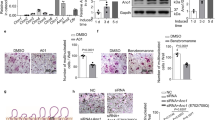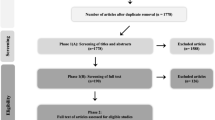Abstract
Accelerated osteoclastic bone resorption has a central role in the pathogenesis of osteoporosis and other bone diseases. Identifying the molecular pathways that regulate osteoclast activity provides a key to understanding the causes of these diseases and to the development of new treatments. Here we show that mice with inactivation of cannabinoid type 1 (CB1) receptors have increased bone mass and are protected from ovariectomy-induced bone loss. Pharmacological antagonists of CB1 and CB2 receptors prevented ovariectomy-induced bone loss in vivo and caused osteoclast inhibition in vitro by promoting osteoclast apoptosis and inhibiting production of several osteoclast survival factors. These studies show that the CB1 receptor has a role in the regulation of bone mass and ovariectomy-induced bone loss and that CB1- and CB2-selective cannabinoid receptor antagonists are a new class of osteoclast inhibitors that may be of value in the treatment of osteoporosis and other bone diseases.
This is a preview of subscription content, access via your institution
Access options
Subscribe to this journal
Receive 12 print issues and online access
$209.00 per year
only $17.42 per issue
Buy this article
- Purchase on Springer Link
- Instant access to full article PDF
Prices may be subject to local taxes which are calculated during checkout






Similar content being viewed by others
References
Teitelbaum, S.L. Bone resorption by osteoclasts. Science 289, 1504–1508 (2000).
Helfrich, M.H. Osteoclast diseases. Microsc. Res. Tech. 61, 514–532 (2003).
Rodan, G.A. & Martin, T.J. Therapeutic approaches to bone diseases. Science 289, 1508–1514 (2000).
Khosla, S. Minireview: The OPG/RANKL/RANK System. Endocrinology 142, 5050–5055 (2001).
Baldock, P.A. et al. Hypothalamic Y2 receptors regulate bone formation. J. Clin. Invest. 109, 915–921 (2002).
Skerry, T.M. & Genever, P.G. Glutamate signalling in non-neuronal tissues. Trends Pharmacol. Sci. 22, 174–181 (2001).
van't Hof, R.J., Macphee, J., Libouban, H., Helfrich, M.H. & Ralston, S.H. . Regulation of bone mass and bone turnover by neuronal nitric oxide synthase. Endocrinology 145, 5068–5074 (2004).
Ducy, P. et al. Leptin inhibits bone formation through a hypothalamic relay: a central control of bone mass. Cell 100, 197–207 (2000).
Takeda, S. et al. Leptin regulates bone formation via the sympathetic nervous system. Cell 111, 305–317 (2002).
Pertwee, R.G. & Ross, R.A. Cannabinoid receptors and their ligands. Prostaglandins Leukot. Essent. Fatty Acids 66, 101–121 (2002).
Ravinet, T.C. et al. Anti-obesity effect of SR141716, a CB1 receptor antagonist, in diet-induced obese mice. Am. J. Physiol. Regul. Integr. Comp. Physiol. 284, R345–R353 (2003).
Shearman, L.P. et al. Antidepressant-like and anorectic effects of the cannabinoid CB1 receptor inverse agonist AM251 in mice. Behav. Pharmacol. 14, 573–582 (2003).
Hildebrandt, A.L., Kelly-Sullivan, D.M. & Black, S.C. Antiobesity effects of chronic cannabinoid CB1 receptor antagonist treatment in diet–induced obese mice. Eur. J. Pharmacol. 462, 125–132 (2003).
Takayanagi, H. et al. Induction and activation of the transcription factor NFATc1 (NFAT2) integrate RANKL signaling in terminal differentiation of osteoclasts. Dev. Cell 3, 889–901 (2002).
David, J.P., Sabapathy, K., Hoffmann, O., Idarraga, M.H. & Wagner, E.F. JNK1 modulates osteoclastogenesis through both c-Jun phosphorylation-dependent and -independent mechanisms. J. Cell Sci. 115, 4317–4325 (2002).
Grigoriadis, A.E. et al. c-Fos: a key regulator of osteoclast-macrophage lineage determination and bone remodeling. Science 266, 443–448 (1994).
Howlett, A.C. et al. International Union of Pharmacology. XXVII. Classification of Cannabinoid Receptors. Pharmacol. Rev. 54, 161–202 (2002).
Takahashi, N., Udagawa, N., Tanaka, S. & Suda, T. Generating murine osteoclasts from bone marrow. Methods Mol. Med. 80, 129–144 (2003).
Coxon, F.P. et al. Protein geranylgeranylation is required for osteoclast formation, function, and survival: inhibition by bisphosphonates and GGTI-298. J. Bone Miner. Res. 15, 1467–1476 (2000).
van't Hof, R.J. et al. Identification of biphenylcarboxylic acid derivatives as a novel class of bone resorption inhibitors. J.Bone Miner.Res. 19, 1651–1660 (2004).
Howlett, A.C., Song, C., Berglund, B.A., Wilken, G.H. & Pigg, J.J. Characterization of CB1 cannabinoid receptors using receptor peptide fragments and site-directed antibodies. Mol. Pharmacol. 53, 504–510 (1998).
Casanova, M.L. et al. Inhibition of skin tumor growth and angiogenesis in vivo by activation of cannabinoid receptors. J. Clin. Invest. 111, 43–50 (2003).
Pryce, G. et al. Cannabinoids inhibit neurodegeneration in models of multiple sclerosis. Brain 126, 2191–2202 (2003).
Armour, K.E. et al. Defective bone formation and anabolic responses to exogenous estrogen in mice with targeted disruption of endothelial nitric oxide sythase. Endocrinology 142, 760–766 (2001).
Acknowledgements
This study was supported by a project grant from the arthritis research campaign to S.H.R., R.A.R. and R.V.H.; a “Proof of Concept” grant to S.H.R., I.R.G. and R.V.H. from Scottish Enterprise; and by a US National Institutes of Health grant to R.A.R. R.V.H. is supported by a project grant from the arthritis research campaign and D.B. is a Multiple Sclerosis Society senior fellow.
Author information
Authors and Affiliations
Corresponding author
Ethics declarations
Competing interests
The authors hold patents on the use of cannabinoid receptor ligands as treatments for bone disease.
Supplementary information
Supplementary Fig. 1
Expression of cannabinoid CB1 and CB2 receptors on osteoclasts. (PDF 102 kb)
Supplementary Fig. 2
Cannabinoid receptor blockade causes apoptosis of mouse and rabbit osteoclasts. (PDF 54 kb)
Supplementary Table 1
Bone histomorphometry in CB1 knockout and wild type mice. (PDF 68 kb)
Supplementary Table 2
Bone histomorphometry in AM251 treated Ovariectomized mice. (PDF 68 kb)
Rights and permissions
About this article
Cite this article
Idris, A., van 't Hof, R., Greig, I. et al. Regulation of bone mass, bone loss and osteoclast activity by cannabinoid receptors. Nat Med 11, 774–779 (2005). https://doi.org/10.1038/nm1255
Received:
Accepted:
Published:
Issue Date:
DOI: https://doi.org/10.1038/nm1255
This article is cited by
-
Effect of recreational cannabis use on bone mineral density: a systematic review
Osteoporosis International (2024)
-
Non-psychoactive Cannabidiol Prevents Osteoporosis in an Animal Model and Increases Cell Viability, Proliferation, and Osteogenic Gene Expression in Human Skeletal Stem and Progenitor Cells
Calcified Tissue International (2023)
-
Analyzing the Impact of Cannabinoids on the Treatment of Spinal Disorders
Current Reviews in Musculoskeletal Medicine (2022)
-
Osteoporosis increases the risk of rotator cuff tears: a population-based cohort study
Journal of Bone and Mineral Metabolism (2022)
-
Examining the role of cannabinoids on osteoporosis: a review
Archives of Osteoporosis (2022)



